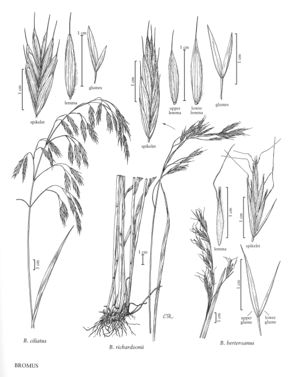Difference between revisions of "Bromus ciliatus"
FNA>Volume Importer |
imported>Volume Importer |
||
| (5 intermediate revisions by 2 users not shown) | |||
| Line 7: | Line 7: | ||
|synonyms={{Treatment/ID/Synonym | |synonyms={{Treatment/ID/Synonym | ||
|name=Bromus dudleyi | |name=Bromus dudleyi | ||
| − | |authority= | + | |authority= |
| + | |rank=species | ||
}} {{Treatment/ID/Synonym | }} {{Treatment/ID/Synonym | ||
|name=Bromus ciliatus var. intonsus | |name=Bromus ciliatus var. intonsus | ||
| − | |authority= | + | |authority= |
| + | |rank=variety | ||
}} {{Treatment/ID/Synonym | }} {{Treatment/ID/Synonym | ||
|name=Bromus canadensis | |name=Bromus canadensis | ||
| − | |authority= | + | |authority= |
| + | |rank=species | ||
}} {{Treatment/ID/Synonym | }} {{Treatment/ID/Synonym | ||
|name=Bromopsis ciliata | |name=Bromopsis ciliata | ||
| − | |authority= | + | |authority= |
| + | |rank=species | ||
}} {{Treatment/ID/Synonym | }} {{Treatment/ID/Synonym | ||
|name=Bromopsis canadensis | |name=Bromopsis canadensis | ||
| − | |authority= | + | |authority= |
| + | |rank=species | ||
}} | }} | ||
|hierarchy=Poaceae;Poaceae subfam. Pooideae;Poaceae tribe Bromeae;Bromus;Bromus sect. Bromopsis;Bromus ciliatus | |hierarchy=Poaceae;Poaceae subfam. Pooideae;Poaceae tribe Bromeae;Bromus;Bromus sect. Bromopsis;Bromus ciliatus | ||
| Line 31: | Line 36: | ||
-->{{Treatment/Body | -->{{Treatment/Body | ||
| − | |distribution=Ala.;Calif.;Iowa;Idaho;Ill.;Ind.;Md.;Mich.;Minn.;N.C.;N.Dak.;Nebr.;N.J.;Nev.;N.Y.;Ohio;Oreg.;Pa.;Tenn.;Utah;Wash.;Wis.;W.Va.;Wyo.;Conn.;Mass.;N.H.;R.I.;Maine;Vt.;N.Mex.;Tex.;Va.;Colo.;Alta.;B.C.;Man.;N.B.;Nfld. | + | |distribution=Ala.;Calif.;Iowa;Idaho;Ill.;Ind.;Md.;Mich.;Minn.;N.C.;N.Dak.;Nebr.;N.J.;Nev.;N.Y.;Ohio;Oreg.;Pa.;Tenn.;Utah;Wash.;Wis.;W.Va.;Wyo.;Conn.;Mass.;N.H.;R.I.;Maine;Vt.;N.Mex.;Tex.;Va.;Colo.;Alta.;B.C.;Man.;N.B.;Nfld. and Labr.;N.S.;N.W.T.;Ont.;P.E.I.;Que.;Sask.;Yukon;Alaska;Ariz.;Mont.;S.Dak.;Ky. |
|discussion=<p><i>Bromus ciliatus</i> grows in damp meadows, thickets, woods, and stream banks across almost all of northern North America except the high arctic, extending further south mainly through the western United States to Mexico. Some taxonomists have named plants with different degrees of sheath pubescence as different forms. Because the variation is continuous, such differences are not formally recognized in this treatment.</p> | |discussion=<p><i>Bromus ciliatus</i> grows in damp meadows, thickets, woods, and stream banks across almost all of northern North America except the high arctic, extending further south mainly through the western United States to Mexico. Some taxonomists have named plants with different degrees of sheath pubescence as different forms. Because the variation is continuous, such differences are not formally recognized in this treatment.</p> | ||
|tables= | |tables= | ||
| Line 41: | Line 46: | ||
-->{{#Taxon: | -->{{#Taxon: | ||
name=Bromus ciliatus | name=Bromus ciliatus | ||
| − | |||
|authority=L. | |authority=L. | ||
|rank=species | |rank=species | ||
| Line 48: | Line 52: | ||
|basionyms= | |basionyms= | ||
|family=Poaceae | |family=Poaceae | ||
| − | |distribution=Ala.;Calif.;Iowa;Idaho;Ill.;Ind.;Md.;Mich.;Minn.;N.C.;N.Dak.;Nebr.;N.J.;Nev.;N.Y.;Ohio;Oreg.;Pa.;Tenn.;Utah;Wash.;Wis.;W.Va.;Wyo.;Conn.;Mass.;N.H.;R.I.;Maine;Vt.;N.Mex.;Tex.;Va.;Colo.;Alta.;B.C.;Man.;N.B.;Nfld. | + | |illustrator=Cindy Roché |
| + | |illustration copyright=Utah State University | ||
| + | |distribution=Ala.;Calif.;Iowa;Idaho;Ill.;Ind.;Md.;Mich.;Minn.;N.C.;N.Dak.;Nebr.;N.J.;Nev.;N.Y.;Ohio;Oreg.;Pa.;Tenn.;Utah;Wash.;Wis.;W.Va.;Wyo.;Conn.;Mass.;N.H.;R.I.;Maine;Vt.;N.Mex.;Tex.;Va.;Colo.;Alta.;B.C.;Man.;N.B.;Nfld. and Labr.;N.S.;N.W.T.;Ont.;P.E.I.;Que.;Sask.;Yukon;Alaska;Ariz.;Mont.;S.Dak.;Ky. | ||
|reference=None | |reference=None | ||
|publication title= | |publication title= | ||
|publication year= | |publication year= | ||
|special status= | |special status= | ||
| − | |source xml=https:// | + | |source xml=https://bitbucket.org/aafc-mbb/fna-data-curation/src/200273ad09963decb8fc72550212de541d86569d/coarse_grained_fna_xml/V24/V24_311.xml |
|subfamily=Poaceae subfam. Pooideae | |subfamily=Poaceae subfam. Pooideae | ||
|tribe=Poaceae tribe Bromeae | |tribe=Poaceae tribe Bromeae | ||
Latest revision as of 16:22, 11 May 2021
Plants perennial; not rhizomatous. Culms 45-120(150) cm, erect; nodes (3)4-7(8), all pubescent or the lower nodes sometimes glabrous; internodes glabrous. Basal sheaths usually retrorsely pilose, sometimes glabrous; upper sheaths glabrous, throats glabrous or pilose, midrib of the culm leaves not abruptly narrowed just below the collar; auricles sometimes present; ligules 0.4-1.4 mm, usually glabrous, rarely pilose, truncate, erose; blades 13-25 cm long, 4-10 mm wide, flat, abaxial surfaces usually glabrous, sometimes pilose, adaxial surfaces usually pilose, sometimes glabrous. Panicles 10-20 cm, open, nodding; branches ascending, spreading, or drooping. Spikelets 15-25 mm, elliptic to lanceolate, terete to moderately laterally compressed, with 4-9 florets. Glumes glabrous; lower glumes 5.5-7.5 mm, 1(3)-veined; upper glumes 7.1-8.5 mm, 3-veined, not mucronate; lemmas 9.5-14 mm, elliptic to lanceolate, rounded over the midvein, backs glabrous, sometimes scabrous, margins conspicuously hirsute on the lower 1/2 - 2/3, apices obtuse to acute, entire; awns 3-5 mm, straight, arising less than 1.5 mm below the lemma apices; anthers 1-1.4 mm. 2n = 14.
Distribution
Ala., Calif., Iowa, Idaho, Ill., Ind., Md., Mich., Minn., N.C., N.Dak., Nebr., N.J., Nev., N.Y., Ohio, Oreg., Pa., Tenn., Utah, Wash., Wis., W.Va., Wyo., Conn., Mass., N.H., R.I., Maine, Vt., N.Mex., Tex., Va., Colo., Alta., B.C., Man., N.B., Nfld. and Labr., N.S., N.W.T., Ont., P.E.I., Que., Sask., Yukon, Alaska, Ariz., Mont., S.Dak., Ky.
Discussion
Bromus ciliatus grows in damp meadows, thickets, woods, and stream banks across almost all of northern North America except the high arctic, extending further south mainly through the western United States to Mexico. Some taxonomists have named plants with different degrees of sheath pubescence as different forms. Because the variation is continuous, such differences are not formally recognized in this treatment.
Selected References
None.
